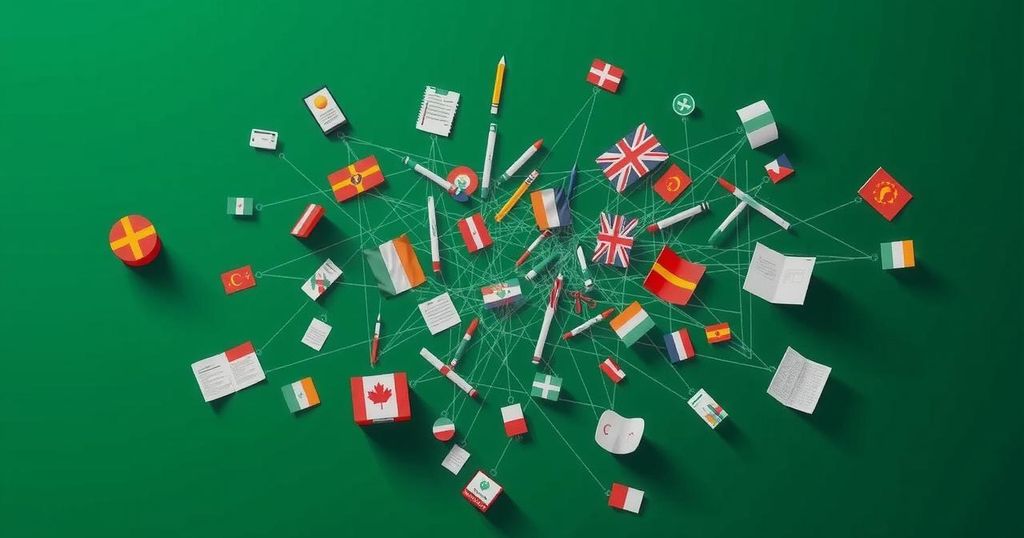Understanding the Irish Election: Continuity Amidst Complexity
The Irish general election resulted in Fianna Fáil and Fine Gael maintaining a combined 43% of votes, reflecting a familiar yet tumultuous political landscape. Sinn Féin, expected to gain ground, instead lost voter share amid internal challenges and competition from right-wing candidates. This election results in critical choices for centre-left parties, as well as ongoing dilemmas for the traditional governing parties, navigating economic uncertainties and public expectations for meaningful change.
The Irish political landscape following the recent general election reveals a striking familiarity. The two predominant parties, Fianna Fáil and Fine Gael, maintained their collective vote share at 43%, similar to the 2020 election. This continuation of their longstanding governance by these parties, since the establishment of the state a century ago, reflects a paradoxical calm amidst a turbulent global political context where many incumbents faced significant losses.
Despite seeming stability, the Fianna Fáil-Fine Gael coalition is experiencing a noticeable decline, having captured nearly 70% of the vote in 2007, but now struggling to secure half. This erosion of support occurs despite economic growth, full employment, and the successful management of crises like Brexit and Covid-19. The election results suggest a complex response from the electorate that cannot be interpreted simply as an endorsement of the status quo.
The opposition party, Sinn Féin, initially expected to ascend to power under the leadership of Mary Lou McDonald, instead became the election’s largest loser, witnessing a decrease in its vote share. This decline can be partially attributed to internal disputes and challenges to its credibility, as well as competing sentiments among the electorate towards right-wing candidates capitalizing on anti-immigrant sentiments. This situation has created opportunities for centre-left parties like Labour and the Social Democrats to reposition themselves amidst the fragmented political landscape.
As these parties consider their positions, they face critical decisions about whether to support the incoming coalition governed by Fianna Fáil and Fine Gael or to carve out an independent path. The potential for increased public spending presents attractive prospects, yet the looming threat of external pressures, such as trade conflicts instigated by the Trump administration, complicates future fiscal policies. Additionally, the recent electoral losses suffered by the Green Party, part of the previous coalition, underscore the shifting allegiances within the current political discourse, revealing vulnerability within these long-standing governing entities.
Ultimately, the election results highlight both continuity and unrest within Irish politics. The incoming government will navigate the delicate balance of sustaining its position while addressing the electorate’s expectations for substantial change—a challenge compounded by a history of unmet promises. Thus, while the political landscape may appear unchanged at first glance, the underlying tensions suggest that significant challenges lie ahead for public leadership in Ireland.
The article discusses the aftermath of the Irish general election, highlighting the continued dominance of the traditional parties, Fianna Fáil and Fine Gael. It contrasts the apparent calm in the political scene with deep-rooted issues, including declining voter loyalty, the rise of opposition parties like Sinn Féin, and shifting political sentiments influenced by social changes and economic conditions. The discussion reflects on how Ireland’s political framework may be affected by external economic factors and internal party dynamics.
The recent election results in Ireland indicate a complex web of political dynamics characterized by continuity and ignited undercurrents of change. While Fianna Fáil and Fine Gael will likely maintain their grip on power, the electorate’s evolving preferences, particularly the challenge presented by Sinn Féin, and the rise of other political factions suggest potential disruptions ahead. The incoming government’s capacity to respond to public demands for substantial reforms will be pivotal in determining its longevity and effectiveness.
Original Source: www.theguardian.com




Post Comment